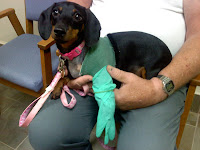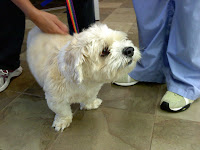The winner of our Patient of the Week poll last week
Boogie with 104 votes!
Your candidates for June 7 thru June 11, 2010 are below:
PATIENT SUMMARY:
Corrie is a Pomeranian. He is 3.5yrs old and weighs 4.1#. His referring veterinarian is Dr. Steven Ambrose of Cloverleaf Animal Clinic. Corrie has been using the right fore well since the last exam confirmed fracture healing. He has had 3 cycles of antibiotics to treat a cyst like structure on the same just off the incisional scar. On radiographs there is no evidence of infection at the bone level. Dr. Dew discussed low grade infection, cyst and tumor. He suggested plate removal, culture and cyst excision with histologic assessment. His owner wished to proceed with the diagnostic and surgical plan, and utilized transport to Russellville.
TREATMENT:
Dr. Dew used a craniolateral approach for Corrie’s surgery. There was no evidence of osteomyelitis or obvious extension of abnormal tissue deep to dermis. He performed an elliptical excision of cyst 1mm margins. This was submitted to AR-State lab, removed plate, culture screw-AR State lab. Corrie’s prognosis is good for soft tissue healing. The pathology and culture results will provide valuable information concerning further treatment and prognosis.
Denver is a Labrador Retriever. He is 62.8# and 9yrs old. His owner and referring veterinarian is Dr. Jon Southerland of Kiehl Avenue Animal Clinic. Denver had a history of multiple gastric distention incidents treated surgically and with stomach tube placement. Incisional issues have been addressed with revision surgery. Gastric distention continued to be a problem. Dr. Dew discussed abdominal exploratory, possible pyloric hypertrophy. He suggested y-u pyloroplasty, biopsy and incisional gastropexy. Dr. Southerland and his wife wished to proceed with surgery.
TREATMENT:Dr. Dew used a ventral celiotomy approach for Denver’s surgery. The spleen was necrotic, and there were multiple adhesions to the liver, spleen and stomach. Initially unable to pass fluid or air through pylorus, and there was a large 4x2x1cm gastric ulcer through mucosa and muscularis. Dr. Dew excised the traumatized dermis and body wall back to level of healthy tissue, and cultured the abdomen. He performed a splenectomy, pyloroplasty, and full thickness biopsy. The gastric ulcer was excised. All were submitted for histologic assessment, along with pyloric tissue. Denver’s prognosis is guarded until he is able to eat without evidence of bloat.
PATIENT SUMMARY:
Lizzy is a Terrier. She is 10 yrs old and weighs 13#. Her veterinarian is Dr. Mark Davenport with Davenport Veterinary Clinic. She had an acute onset of left rear lameness. Dr. Davenport identified a left CCL injury. Upon exam, she had positive anterior drawer and medial buttress in the left stifle consistent with CCL rupture. Grade II MPL was also noted. Dr. Dew discussed CCL/MPL correction with TTA (tibial tuberosity advancement). Her owner wished to proceed with TTA.
TREATMENT:
Dr. Dew used a medial approach with medial arthrotomy for the surgery. He cancellous bone from trochleoplasty, explore, debride, lavage joint, and performed tibial tuberosity osteotomy. The Kyon implants used to stabilize were as follows: 6x16mm basket, 3 hole plate & fork, and 4 titanium screws.
Lizzy’s prognosis is good for healing, improved function and decreased progression of degenerative joint disease (arthritis). Nursing care, physical therapy, exercise restriction and the use of Glycoflex will play critical roles in an uncomplicated recovery and optimization of long term function. With the TTA procedure, it is not uncommon to see some bruising and edema around the hock (ankle) and on the inside of the leg below the incision. These changes are not painful and will resolve without treatment in 3-10 days.
PATIENT SUMMARY:
Bear is a Bichon Frise. He is 9yrs old and weighs 22#. Dr. Jon Southerland of Kiehl Avenue Animal Clinic is Bear’s referring veterinarian. He had an acute onset of right rear lameness 1 month previous after jumping off of a low deck. Dr. Southerland identified a right CCL rupture. Upon examination, positiveanterior drawer and medial buttress were consistent with CCL rupture. Dr. Dew discussed TTA (tibial tuberosity advancement) and EFS (external fascial strip) procedures, the owners wished to proceed with a right EFS.
TREATMENT:
Dr. Dew used a lateral approach with lateral arthrotomy. He proceeded to explore, debride, lavage, and imbricate joint EFS, He used medial buttress suture 0-PDS, advanced biceps, lavaged, and close. Bear’s prognosis is good for healing, improved function and decreased progression of degenerative joint disease (arthritis). Nursing care, physical therapy, exercise restriction and the use of Glycoflex will play critical roles in an uncomplicated recovery and optimization of long term function.
PATIENT SUMMARY:
Lola is a Labrador Retriever. She weighs 70# and is 4.5 yrs old. Her referring veterinarian is Dr. James Butler of Rye Hill Veterinary Clinic. Lola had an acute onset of right rear lameness in January. Dr. Butler identified a CCL injury. Upon exam, positive anterior drawer and medial buttress were consistent with CCL rupture. Dr. Dew discussed TTA (tibial tuberosity advancement) and EFS (external fascial strip) procedures. Her owner wished to proceed with TTA.
TREATMENT:
Dr. Dew used a medial approach with medial arthrotomy. He harvested cancellous graft distal femur, explored, debrided, lavage joint, tibial tuberosity osteotomy. The Kyon hardware used to stabilize was as follows: 9x22mm basket, 6 hole plate & fork, and 4 titanium screws. Lola’s prognosis is good for healing, improved function and decreased progression of degenerative joint disease (arthritis). Nursing care, physical therapy, exercise restriction and the use of Glycoflex will play critical roles in an uncomplicated recovery and optimization of long term function. With the TTA procedure, it is not uncommon to see some bruising and edema around the hock (ankle) and on the inside of the leg below the incision. These changes are not painful and will resolve without treatment in 3-10 days.
PATIENT SUMMARY:
Izzy is a Miniature Dachschund. She is 8 months old and weighs 9#. Dr. John Lewis of Jacksonville-Cabot Veterinary Clinic is her referring veterinarian. Izzy had forelimb lameness, which was worsening as she was getting older. Dr. Lewis identified a radioulnar incongruity with subluxation of the radius. Dr. Dew discussed partial ulnar ostectomy and reduction of radius, and improvement should be noted however degenerative changes will progress with age. Izzy’s owner decided to proceed with corrective surgery.
TREATMENT:
Dr. Dew used a caudal approach for Izzy’s surgery. He performed a partial ulnar ostectomy, reduced radius, and stabilize with transarticular IM wire 0.062. Izzy’s prognosis is good for uncomplicated healing. The pin will need to be removed in 3- 4 weeks time. Exercise restrictions must be followed to maximize the prognosis for uncomplicated healing.
PATIENT SUMMARY:
Sammy is a Miniature Schnauzer. He is 7 mo old and weighs 12#. His referring veterinarian is Dr. Floyd Mann of Apple Farm Veterinary Hospital. Sammy was accidentally stepped on, and Dr. Mann identified a fracture of the distal radius/ulna on the left. Upon exam by Dr. Dew, the limb was unsupported, and the fracture was palpable approximately 1-1/2 cm above the radiocarpal joint. Dr. Dew discuss ESF (external stabilization Fixator) and IM pin stabilization with a good prognosis for healing and return to function. The owner wished to proceed.
TREATMENT:
Dr. Dew used a craniomedial approach for Sammy’s surgery. The fracture was stabilized with 2 IM 0.062 wires. Sammy’s prognosis is good for normal osseous healing. Exercise restrictions must be followed to maximize the prognosis for uncomplicated healing.
PATIENT SUMMARY:
Suzie is a Miniature Dachschund at 5yrs old and 10#. Her referring veterinarian is Dr. Mary Ann Boone of Pointer Trail Animal Clinic. Suzie has had an acute onsent of rear limb paralysis.
TREATMENT:
Cerebrospinal centesis: Dr. Dew obtained 2ml of clear CSF from cisterna magna.
Myelogram: Using a lumber injection of 2.5ml iohexol, column thinning from T10-T13 could be observed. There was a slight deviation of the spinal cord to the right at T11-12.
Hemilaminectomy: Dr. Dew used a dorsolatral approach to the left T11-12. He observed a large amount of disc material which was removed lateral and ventral to cord, acute and chronic. The cord moved to its normal position post disc removal. Suzie’s prognosis is good for healing and improved neurologic function. A transient worsening of neurologic function can be noted after a myelogram and surgery. This condition will usually resolve to the pre-operative state in 3-10 days. The nervous system is very slow to heal. Improvement can be expected for up to 5 months. Nursing care, physical therapy and exercise restriction all play critical roles in avoiding complications and aiding recovery.
PATIENT SUMMARY:
Jasper is a Cocker Spaniel. He weighs 40# and is 8yrs and 3mo old. Dr. James Ralston of Ralston Animal Hospital is his referring veterinarian. Jasper has had a history of chronic, recurrent otitis. Upon examination, his ear canals were filled with hypertrophied tissue and have significant discharge. Dr. Dew discussed bilateral TECA (total ear canal ablation), complications, recovery and prognosis. His owner wished to proceed with surgery.
TREATMENT:
Dr. Dew used a lateral approach with lateral bulla osteotomy. The facial nerve was visualized and protected. Bilateral TECA were performed along with bulla osteotomy, curette bulla, lavaged, also placed ¼” penrose drain in bulla. Jasper should recover well from surgery and resolution of the ear disease should be the end result. Facial nerve palsy can be noted after surgery. This is normally transient, resolving in 3-14 days. The chance of complications will be drastically reduced by following discharge instructions and maintaining the E-collar.
PATIENT SUMMARY:
Otto is a Dachshund weighing 15# and is 6yrs and 6mo old. His referring veterinarian is Dr. Amy Goodnow at McCune Animal Hospital. Otto had rear limb weakness and discomfort that had worsened since last visit with us. His owner wished to proceed with myelogram and surgery if indicated.
TREATMENT:
Cerebrospinal centesis: 1 ml of clear CSF collected from lumbar puncture-submitted to Antech.
Myelogram: Using 3ml iohexol lumbar injection.
Observations: No compressive or expansile lesions of significance noted.
Stifle radiographs show no evidence of joint effusion or CCL degeneration. We suggested to proceed with conservative treatment until the lab results are returned. Transient worsening of a neurologic condition can be seen after a myelogram. Normally these changes resolve within 3-5 days. Please limit activity and give any medications as directed. The spinal fluid analysis as well as response to therapy may allow us to give "Otto" a more accurate prognosis for recovery.
PATIENT SUMMARY:
Toby is a Lhasa Apso/Shih Tzu mix. He is 8yrs old and weights 23#. Dr. Cheryl Adkins of Labahn Veterinary Hospital is his referring veterinarian. Toby had a history of 2 bouts of cervical pain and left forelimb dysfunction, both incidences have responded to NSAID's and muscle relaxants. Upon examination, Toby is fully ambulatory with some evidence of cervical guarding. Cervical IVDD was discussed; due to repeated bouts of discomfort Ms. Roy wished to pursue a myelogram and surgery if indicated.
TREATMENT:
Cerebrospinal centesis: 1 ml clear CSF was collected from lumbar puncture-submitted to Antech.
Myelogram: 2-4ml iohexol, lumbar injection.
Observations: No evidence of a compressive lesion in T/L or cervical spine. Several mineralized discs are evident. Flexed view does not demonstrate cord compression or instability. Transient worsening of a neurologic condition can be seen after a myelogram. Normally these changes resolve within 3-5 days. Please limit activity and give any medications as directed. The spinal fluid analysis as well as response to therapy may allow us to give "Toby" a more accurate prognosis for recovery.















Hi, Thanks for putting Corrie on the blog. I can't seem to cast my vote. There is not a vote button that I can see. I have tried Safari and Firefox. I have a Macbook. Could that be the problem? Thanks Pam
ReplyDeletePam, sorry, we switched to a new poll. The vote button should be visible now.
ReplyDelete